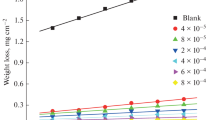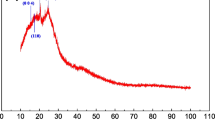Abstract
C8F17SO2NH(CH2)3N(CH3)2(CH2COO)Na (PNHD) is a novel amphoteric fluorinated surfactant. The corrosion inhibition of PNHD and its mixed systems with cetyl trimethylammonium bromide (CTAB) or octylphenol ethoxylate 9.5 EO (TX-10) for carbon steel Q235 in 1.0 M HCl solution was studied in this paper. The corrosion inhibition efficiency (η) was determined by weight loss, electrochemical methods and scanning electron microscope. The values of η from the three methods were almost identical. The hydrophilic head group of PNHD has two lone pairs of electrons at the nitrogen atoms, suggesting a chemisorption mechanism between carbon steel and surfactant. The PNHD and mixed systems inhibitors acted as a mixed inhibitor; there is interaction between PNHD and CTAB or TX-100. A compact protective film was formed in PNHD and its mixed systems.





Similar content being viewed by others
References
Trabanelli G (1991) Inhibition an old remedy for a new challenge. Corrosion 47:410–419
Bentiss F, Traisnel M, Vezin H, Hildebrand HF, Lagrenee M (2004) 2,5-bis (4-dimethylaminophenyl)-1,3,4-oxadiazole and 2,5-bis(4-dimethylaminophenyl)-1,3,4-thiadiazole as corrosion inhibitors for mild steel in acidic media. Corros Sci 46:2781–2792
Lebrini M, Lagrenee M, Vezin H, Gengembre L, Bentiss F (2005) Electrochemical and quantum chemical studies of new thiadiazole derivatives adsorption on mild steel in normal hydrochloric acid medium. Corros Sci 47:485–505
Mohammed A, Ahmed MA, Arida HA, Kandemirli F, Saracoglu M, Arslan T, Basaran MA (2011) Monitoring corrosion and corrosion control of iron in HCl by non-ionic surfactants of the TRITON-X series–Part III. Immersion time effects and theoretical studies. Corros Sci 53:1895–1909
Villamil RFV, Cordeiro GG, Matos J, D’Elia E, Agostinho SML (2003) Effect of sodium dodecylsulfate and benzotriazole on the interfacial behavior of Cu/Cu(II), H2SO4. Mater Chem Phys 78:448–465
Fuchs Godec R, Dole_cek VA (2004) Effect of sodium dodecylsulfate on the corrosion of copper in sulphuric acid media. Coll Surf A 244:73–76
Fuchs Godec R (2006) The adsorption, cmc determination and corrosion inhibition of some N-alkyl quaternary ammonium salts on carbon steel surface in 2 M H2SO4. Coll Surf A 280:130–139
Migahed MA (2005) Electrochemical investigation of the corrosion behaviour of mild steel in 2 M HCl solution in presence of 1-dodecyl-4-methoxy pyridinium bromide. Mater Chem Phys 93:48–53
Popova A, Christov M, Vasilev A (2007) Inhibitive properties of quaternary ammonium bromides of N-containing heterocycles on acid mild steel corrosion. Part I: gravimetric and voltammetric results. Corros Sci 49:3276–3289
Fuchs Godec R (2007) Effect of the nature of the counterions of N-alkyl quaternary ammonium salts on inhibition of the corrosion process. Acta Chim Slov 54:492–501
Negm NA, Sabagh AM, Migahed MA, Abdel Bary HM, ElDin HM (2010) Effectiveness of some diquaternary ammonium surfactants as corrosion inhibitors for carbon steel in 0.5 M HCl solution. Corros Sci 52:2122–2132
Algaber AS, El-Nemma EM, Saleh MM (2004) Effect of octylphenol polyethylene oxide on the corrosion inhibition of steel in 0.5 M H2SO4. Mater Chem Phys 86:26–32
Li X, Deng S, Mu G, Fu H, Yang F (2008) Inhibition effect of nonionic surfactant on the corrosion of cold rolled steel in hydrochloric acid. Corros Sci 50:420–430
Fuchs Godec R (2007) Inhibitory effect of non-ionic surfactants of the TRITON-X series on the corrosion of carbon steel in sulphuric acid. Electrochim Acta 52:4974–4981
Fuchs Godec R, Zerjav G (2009) Inhibition properties of TRITON-X-100 on ferritic stainless steel in sulphuric acid at increasing temperature. Acta Chim Slov 56:78–85
Fuchs Godec R, Zerjav G, Pavlovic MG, Tomic M (2012) Effect of temperature on the corrosion inhibition of nonionic surfactant TRITON-X-100 on ferritic stainless steel in H2SO4. Ind Eng Chem Res 51:274–284
Branzoi V, Golgovici F, Branoi F (2002) Aluminium corrosion in hydrochloric acid solutions and the effect of some organic inhibitors. Mater Chem Phys 78:122–131
Hegazy MA (2009) A novel Schiff base-based cationic gemini surfactants: synthesis and effect on corrosion inhibition of carbon steel in hydrochloric acid solution. Corros Sci 51:2610–2618
Achouri ME, Infante MR, Izquierdo F, Kertit S, Gouttaya HM, Nciri B (2001) Synthesis of some cationic gemini surfactants and their inhibitive effect on iron corrosion in hydrochloric acid medium. Corros Sci 43:19–35
Huang W, Zhao J (2006) Adsorption of quaternary ammonium gemini surfactants on zinc and the inhibitive effect on zinc corrosion in vitriolic solution. Coll Surf A 278:246–251
Qiu LG, Wang YM, Jiang X (2008) Synergistic effect between cationic gemini surfactant and chloride ion for the corrosion inhibition of steel in sulphuric acid. Corros Sci 50:576–582
Qiu LG, Xie AJ, Shen YH (2004) Understanding the adsorption of cationic gemini surfactants on steel surface in hydrochloric acid. Mater Chem Phys 87:237–240
Qiu LG, Xie AJ, Shen YH (2005) The adsorption and corrosion inhibition of some cationic gemini surfactants on carbon steel surface in hydrochloric acid. Corros Sci 47:273–278
Qiu LG, Xie AJ, Shen YH (2005) A novel triazole-based cationic gemini surfactant: synthesis and effect on corrosion inhibition of carbon steel in hydrochloric acid. Mater Chem Phys 91:269–273
Fuchs Godec R (2009) Effects of surfactants and their mixtures on inhibition of the corrosion process of ferritic stainless steel. Electrochim Acta 54:2171–2179
Hosseini M, Mertens FL, Arshadi MR (2003) Synergism and antagonism in mild steel corrosion inhibition by sodium dodecylbenzenesulphonate and hexamethylenetetramine. Corros Sci 45:1473–1489
Asefi D, Mahmoodi NM, Arami M (2010) Effect of nonionic cosurfactants on corrosion inhibition effect of cationic gemini surfactant. Coll Surf A 355:183–186
Asakawa T, Mouri M, Miyagishi S (1989) Probe methods for the second cmc of fluorocarbon and hydrocarbon surfactant mixtures. Langmuir 5:343–348
Wen G, Tommy A, Brown Fung BM (1991) Micelles and aggregates of fluorinated surfactants. J Phys Chem 95:1829–1836
Shrestha R, Shrestha L, Sharma S, Aramaki K (2008) Phase behavior and microstructures of nonionic fluorocarbon surfactant in aqueous systems. J Phys Chem B 112:10520–10527
Ropers MH, Stebe MJ (2003) Incorporation of fluorocarbon in fluorinated surfactant based liquid crystals. Langmuir 19:3137–3144
Dai C, Du M, Zhao M, You Q, Guan B, Wang X, Liu P (2013) Study of micelle formation by fluorocarbon surfactant N-(2-hydroxypropyl) perfluorooctane amide in aqueous solution. J Phys Chem B 117:9922–9928
Takahashi Y, Kondo Y, Schmilt J, Talmon Y (2010) Self-assembly of a fluorocarbon–hydrocarbon hybrid surfactant: dependence of morphology on surfactant concentration and time. J Phys Chem B 114:13319–13325
Xing R, Lemler H, Lehmler H, Knutson B, Rankin S (2009) Synthesis and tuning of bimodal mesoporous silica by combined hydrocarbon/fluorocarbon surfactant templating. Langmuir 11:6486–6492
Unsal H, aydogan N (2009) A new strategy to form multicompartment micelles: Fluorocarbon–hydrocarbon ion-pair surfactant. Langmuir 25:7884–7891
Weiss TM, Narayanan T, Gradzielski M (2008) Dynamics of spontaneous vesicle formation in fluorocarbon and hydrocarbon surfactant mixtures. Langmuir 24:3759–3766
Dong S, Xu G, Hoffmann H (2008) Aggregation behavior of fluorocarbon and hydrocarbon cationic surfactant mixtures: a study of 1H NMR and 19F NMR. J Phys Chem B 112:9371–9378
Dong S, Li X, Xu G, Hoffmann H (2007) A cationic fluorocarbon surfactant DEFUMACI and its mixed systems with cationic surfactants: 19F NMR and surface tension study. J Phys Chem B 111:5903–5910
Calik P, Ileri N, Erdinc BI (2005) Novel antifoam for fermentation processes: fluorocarbon–hydrocarbon hybrid unsymmetrical bolaform surfactant. Langmuir 21:8613–8619
Asakawa T, Ishino S, Hansson P, Almgren M, Ohta A, Miyagishi S (2004) Appearance of pure fluorocarbon micelles surveyed by fluorescence quenching of amphiphilic quinoline derivatives in fluorocarbon and hydrocarbon surfactant mixtures. Langmuir 20:6998–7003
Nakano T, Sugihara G, Nakashima T, Yu S (2002) Thermodynamic study of mixed hydrocarbon/fluorocarbon surfactant system by conductometric and fluorimetric techniques. Langmuir 18:8777–8785
Fuchs Godec R, Pavlovic MG (2012) Synergistic effect between non-ionic surfactant and halide ions in the forms of inorganic or organic salts for the corrosion inhibition of stainless-steel X4Cr13 in sulphuric acid. Corros Sci 58:192–201
Acknowledgments
The National Natural Science Foundation of China (No. 21463016) is gratefully acknowledged.
Author information
Authors and Affiliations
Corresponding author
About this article
Cite this article
Liu, Jy., Wang, Zs., Yang, Wy. et al. Inhibition Performance of Amphoteric Fluorinated Surfactant and its Mixed Systems on Carbon Steel in Hydrochloric Acid. J Surfact Deterg 19, 1297–1304 (2016). https://doi.org/10.1007/s11743-016-1863-2
Received:
Accepted:
Published:
Issue Date:
DOI: https://doi.org/10.1007/s11743-016-1863-2




